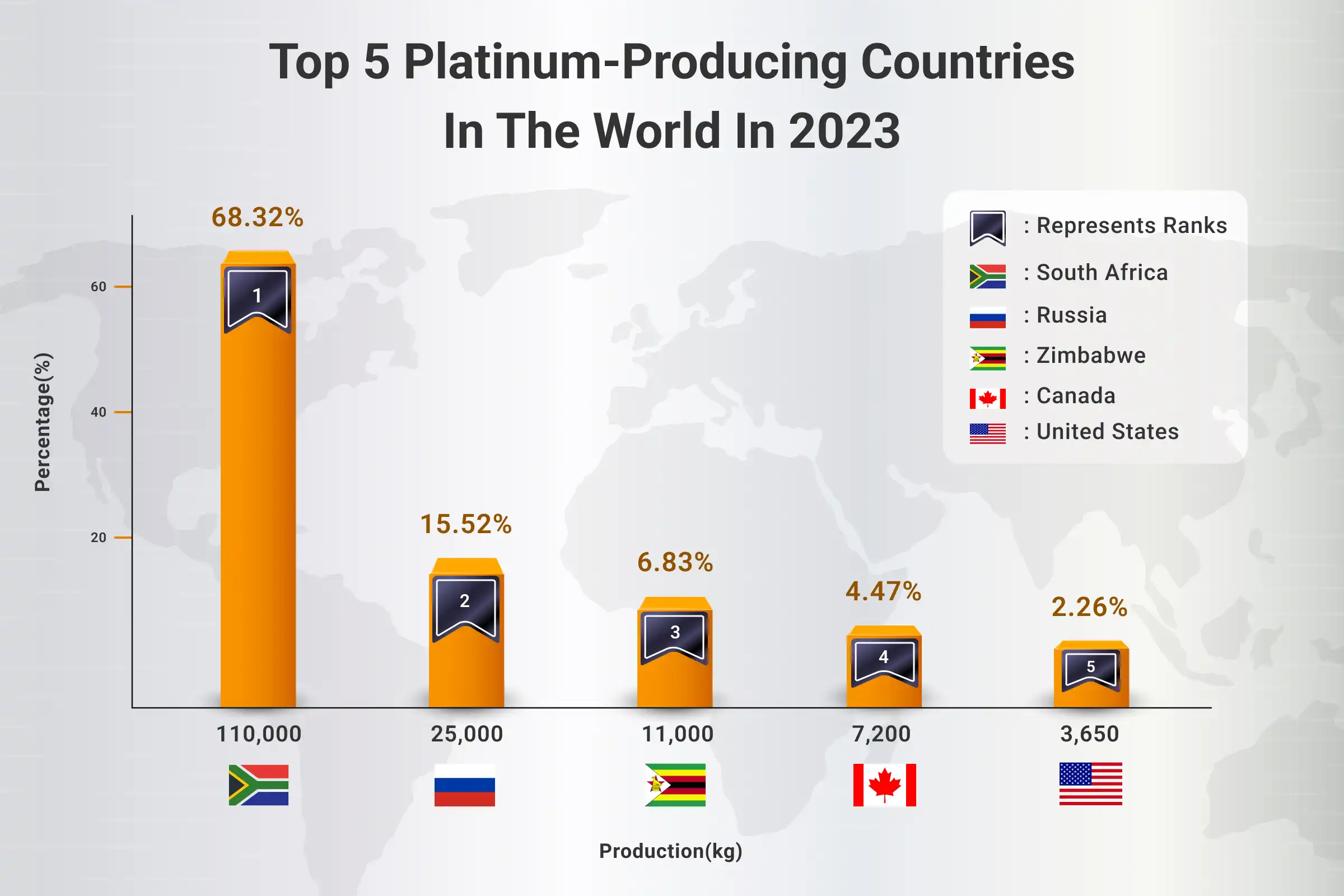Predicting Platinum Prices: How AI Models Offer a Better View for 2024

Introduction
Using AI models to forecast platinum prices for 2024 is necessary to investigate a wide range of intricate variables that affect market dynamics. These days, AI technologies can process enormous amounts of data from a variety of sources, including historical price movements, mining output, and current global economic indicators. Hence, AI is used to provide predictions that are more accurate than those made with more traditional methods.
The AI model by PriceVision uses algorithms to spot trends and patterns that human analysts might not see right away. An AI model might, for example, associate variations in the price of platinum with variations in the demand for catalytic converters from the automobile industry or with changes in investment patterns during periods of economic uncertainty, which is considered difficult for a human analyst.
What are the Factors that Influence Platinum Prices?
Platinum price is determined by a wide range of interrelated factors, similar to other precious metals in the market. These are broadly divided into four categories: technological breakthroughs, geopolitical events, economic indicators, and supply and demand dynamics. When navigating the platinum price forecast, traders, analysts, and investors must thoroughly understand these aspects carefully.
1. Supply Dynamics
● Mining Production: Most of the world's mining is done in South Africa, Russia, and Zimbabwe as platinum is quite rare. Any disturbances in these areas, whether brought on by labor strikes, natural disasters, or geopolitical unrest, can have a big effect on the world's supply and, in turn, can affect the prices.
● Recycling: Car catalytic converter recycling accounts for a large share of the supply of platinum. The effectiveness and volume of recycling operations can affect market supply and, consequently, platinum price.
● Investment Holdings: Governments and investment funds hold reserves of platinum, just like they do gold and silver. These significant holders' purchases and sales actions can affect platinum prices and perceptions of platinum market supply.
● Automotive Industry: To eliminate harmful emissions from car exhaust systems, catalytic converters require platinum as a critical component. Adjustments to car production levels, modifications to pollution regulations, and the move toward electric vehicles (EVs) impact demand for platinum.
2. Industrial Use:
Platinum is used in a wide range of industries other than jewelry and automobiles. It includes chemical production, electronics, and fuel cells for sustainable energy sources. Industrial demand is linked to the state of the economy as a whole and technological improvements. Hence, any change in the demand or supply of these industries will hamper the prices of the platinum.
3. Financial Metrics
In the international market, platinum is priced in US dollars. Consequently, changes in the value of the dollar may have an impact on live platinum prices. Platinum becomes less expensive in other currencies as the dollar declines, which could lead to a rise in demand, and vice versa.
4. Inflation
Platinum can act as a hedge against inflation because it is a tangible asset. Demand for platinum and other precious metals rises in response to rising inflation as investors look to preserve their purchasing power of these precious metals.
5. Geopolitical Events
An important factor is political instability in major platinum-producing nations. Any uncertainties, including politics, can disrupt supply chains. Even small changes in regulations, or penalties, can impact costs and availability of the metal globally.
6. Technological Progress
Innovations have the potential to change platinum price demand trends, especially in the fields of renewable energy and automotive technologies. For instance, improvements in fuel cell technology which is needed for hydrogen fuel cells as a catalyst may increase the platinum market.
7. Speculation in the Market
Speculative trading impacts the short-term price volatility of platinum prices and derivatives. Price swings may occur regardless of the dynamics of supply and demand at the moment. As for traders' expectations of future shifts in supply and demand. These are impacted by the aforementioned factors.
Top 5 Platinum-Producing Countries in The World in 2023

Source:https://orionmetalexchange.com/5-platinum-producing-countries/
What is the Role of AI Models in Predicting Platinum Prices?
Since the analysts have started using artificial intelligence, predicting the future prices of commodities in commodity market like gold, silver, and oil has improved a lot. It's become smarter and quicker than it used to be:
1. Generative vs. Discriminative Models:
Generative models, often use unsupervised learning to predict the joint probability of data points within a space. It enables them to generate new data that resembles the training data and helps in the prediction of future prices. Discriminative models, typically using supervised learning, focus on the conditional probability of a data point belonging to a certain class, making them suitable for classification tasks.
Source: https://www.ibm.com/topics/ai-model
2. Large Language Models (LLMs):
LLMs like Mistral 7B are designed to generate coherent text and handle various natural language processing tasks. These models are noted for their impressive performance across benchmarks, including commonsense reasoning, world knowledge, and coding tasks. They are characterized by their ability to process and generate human-like text, making them instrumental in applications such as chatbots, content creation, and language translation.
Source: https://viso.ai/deep-learning/ml-ai-models/
3. Decision Trees and Random Forests:
Decision trees use a flowchart-like structure to make decisions based on data, whereas random forests aggregate the inputs of multiple decision trees to make more accurate predictions. These models are beneficial for segmentation, classification, and predicting behaviors.
Source: https://www.snowflake.com/guides/ai-models-what-they-are-and-how-they-work
4. Neural Networks:
Comprising multiple layers of interconnected nodes, neural networks are foundational blocks of deep learning. They excel at managing complexity and analyzing vast amounts of data, making them useful across a range of applications, from speech recognition to inventory optimization. Hence, they can be considered as a great resource for the price prediction software.
Source: https://www.snowflake.com/guides/ai-models-what-they-are-and-how-they-work
AI can predict the prices of platinum quite faster and in a way that humans haven't seen before. This innovative technology can surely create accurate forecasts regarding the price of platinum by analyzing a wide range of data points. This isn't only about what's going on right now in terms of buying and selling, but also about other factors that can influence prices.
People who trade platinum can make faster and more informed decisions by utilizing artificial intelligence. They can identify patterns and trends to assist them in determining whether to buy or sell. This means businesses can make better procurement and trading decisions now that they have all of the information provided by AI.
What are the Factors Considered by AI in Platinum Prices Forecasting?
Artificial intelligence is driving a significant shift in how we conduct platinum price forecast. AI can analyze large amounts of data and generate accurate predictions about what will happen next to the prices of multiuse metals such as platinum. This is transforming the way metals researchers and investors think about their work.
1. Understanding What People Think and Do:
AI analyzes news, what people say on the internet, expert reports, and where money flows to determine how people feel about the market. Knowing what individuals believe and do can help predict whether the live Platinum Prices will vary.
2. Looking at Past Prices:
AI also monitors platinum prices in advance to identify patterns. If something happened in the past, it could happen again if the circumstances are identical. AI uses this data to produce accurate predictions.
3. The Power of Money:
The live Platinum Prices fluctuate with the value of money, particularly dollars. If the dollar is not strong, people with other currencies may find platinum cheaper and wish to buy more.
4. Money Rules:
The amount of interest people receive can also have an impact on platinum price projections. If interest rates are low, people may opt to invest in platinum rather than somewhere else where they can earn more interest.
As a result, AI is assisting individuals in understanding future prices of platinum by taking into account all of those factors. It's like having a crystal ball, but much smarter and based on a wealth of data!
Conclusion
AI is extremely crucial in predicting Platinum prices in 2024. It excels in analyzing large amounts of complex data and making informed predictions about what the price will be right now. This makes AI extremely useful in the bustling business of buying and selling commodities such as platinum.
Price Vision's AI is more than simply a useful tool; it's an essential companion for everyone who trades, studies, or invests in their day-to-day lives. It allows companies to better handle variations in live platinum prices. Using AI, projecting Platinum Prices is becoming a lot clearer and more promising. It's like having a particular window that allows us to observe and grasp the complex world of platinum pricing with greater ease and confidence.
FAQs
● Is platinum worth buying in 2024?
Yes, it is a very important investment to add to your investment portfolio for wonderful growth.
● What is the Forbes prediction for AI in 2024?
In 2024, technology companies (particularly AI and offshore firms) will continue exploring, developing, and deploying swarms of micro-models, rather than single LLM models, to support their AI products and delivery.
● What is the future of AI in 2024?
The future of AI in 2024 is expected to be characterized by rapid technological advancements, broader adoption across industries, and an emphasis on developing AI that is more responsible and regulated